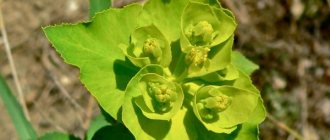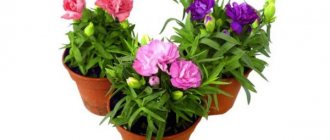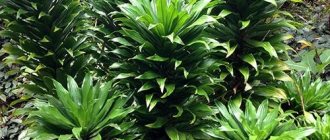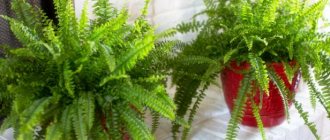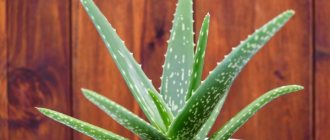Plants » Flowers
0
3344
Article rating
Kira Stoletova
Species of milkweed are very popular among flower growers, professionals and amateurs. These plants are varied in form, but equally poisonous in content. Euphorbia Euphorbia Lactea cristata has the most unusual form.
Euphorbia Lactea cristata
Milk spurge is difficult to find on shelves. This is a special decorative crop, the best choice for true connoisseurs and lovers of extravagant forms.
Home care
How to water?
Different types of milkweed require different watering regimes.
Succulents need little water; a small amount of water is enough for them. You can simply moisten the soil every time it dries out. If you forget to water the spurge succulent, it will not get any worse; only systematic breaks are critical. But the less the plant looks like a succulent, the more water it needs. Dry soil cannot be left, but moistening it or filling it with reserve depends on the type. Like other houseplants, the frequency and amount of watering should be reduced during the dormant period.
Does not require spraying and is indifferent to air humidity levels.
Trimming
After flowering, you need to cut off the bracts, you can also cut off the tops. At the same time, it is better not to touch the largest and healthiest stems, otherwise they will not bloom next year. Dry shoots and leaves should always be cut or broken off, regardless of the season.
Feeding and fertilizer
It does not require additional feeding; moreover, excess mineral fertilizers can be harmful. Euphorbia can be fed only in small quantities during the flowering period. You can use complex fertilizers for deciduous plants or for succulents, depending on what type of particular spurge is.
In spring, fertilizers are added once a month, in summer - twice a month, always in a minimum dosage.
How to care during the dormant period?
At the end of summer, you need to stop feeding and gradually begin to reduce the frequency and volume of watering. During the dormant period, the optimal temperature for milkweed is about 14 degrees. There is no need to water it abundantly at this time, just lightly moisten the soil.
As spring approaches, the frequency and volume of watering should be increased to prepare the plant for awakening and growth.
Features of transplantation
Euphorbia needs transplants to expand space for roots and renew the soil; it tolerates them well. The older the plant, the less often it needs to be replanted. You need to put drainage in the new pot and sprinkle it with soil. Remove the spurge from the old pot, shake off the soil from the roots as best as possible, get rid of their damaged areas, place them in a new pot and cover them with soil.
Water and place in the shade until rooting, then return to the usual lighted place. Replanting is carried out annually (for old plants once every 3-4 years) in the spring.
Pot
The best option for a pot is deep and not very wide. Holes at the bottom are desirable for sufficient oxygen supply; in this case, the pot should be kept in a tray.
Soil and drainage
The bottom of the pot needs drainage made of pebbles or expanded clay. Soil is poured onto it from a mixture of equal parts of peat, sand, leaf soil and turf. You can buy ready-made soil for succulents (even if this type of milkweed is not one of them).
Diseases of milkweed
Lactea can get sick if the rules of care are not followed. The most common disease of cristate euphorbias is rot.
Putrefactive processes develop on the rootstock shoot or ridge at high air or soil humidity. When rot appears, the plant must be pruned immediately. If the disease develops on the rootstock, the ridge can be grafted onto the new shoot.
Lactea Cristata pleases the eye and excites the imagination. This is a noble plant that requires attention. For healthy growth, milkweed Lactea cristata requires moderate temperatures, moderate light and moderate watering. The efforts made will not be in vain.
Varieties
From 800 to 2000 varieties of this plant are known. About 160 species can grow in Russia. Of the 160 species, only a few are suitable for decorative purposes, the rest are used in medicine.
Triangular spurge (triangular)
Or euphorbia trigone. This is a large plant that, even in indoor conditions, can grow several meters upward in a few years.
The main feature is the triangular fleshy stem. Its diameter can reach up to 6-15 cm.
The ribs of the stems are crowned with dark spines. The tops of the shoots are covered with small leaves, no more than 5 cm long. The stems are always located vertically and tend upward. Despite the thick stems they are quite fragile.
Tirukalli (Rubber)
African spurge is a succulent. The main part of the moisture is stored in the stems. The shoots are rod-shaped and long. Leaves and spines are missing. The shoots branch heavily. During flowering, small yellow flowers appear on them. The milky sap is also very poisonous; the plant should be kept away from small children.
Interesting! Plant juice is used in the production of rubber and insecticides for insects
White veined (euphorbia leuconeurae)
Succulent stem plant. It grows naturally on the island of Madagascar. There it forms impenetrable thickets 1.5 m high. Only in the 20th century did white-veined spurge begin to be grown at home.
Externally, the succulent looks like a palm tree. The upright trunk has 5 sides and is colored gray-brown. The leaf blade has a regular oval shape, an even edge, and an emerald green color. In spring, small white flowers form on the plant. The fruit is represented by a seed capsule. It is also called monkey palm.
Beautiful or poinsettia
This is the famous poinsettia, which is given and bought for the Christmas holidays; it blooms during Catholic Christmas. The flowers themselves are inconspicuous; the bright red bracts bear all the value. Growing poinsettia at home is quite difficult. The flower reacts poorly to changes in location and often drops all its foliage after acclimatization. The main thing in care is to observe the temperature and humidity conditions.
mile
Popularly, milkweed is called the crown of thorns. The plant is unpretentious, so it can often be found in schools, offices and public places. It has an erect stem with many spines. At the top of the stems there is a mop of oval-shaped green leaves. The main decorative value is the white or pink bracts, which stand out brightly against the background of the foliage.
The plant loves the sun very much, it is better to place it on a southern windowsill.
Bordered
Another name is marginata, rich bride, mountain snow or “snow on the mountain.” This is a small annual shrub that is often planted in gardens and flower beds. Grows in the mountains of North America. During flowering, euphorbia is covered with snow-white flowers, which really resembles snow cover on mountain peaks.
The leaf plates are decorated with white edging. The flowers are white, small in size, concentrated at the end of the shoots.
Euphorbia Pallas fischeriana
“Man root” is often used in medicine; Fischer’s milkweed is believed to bestow male strength. Plant juice kills bacteria and relieves inflammation. Grows in the lands of China and Korea.
The stem is erect, 35-40 cm high. The leaves take the shape of a narrow ellipse. The upper part of the shoots is crowned with yellow-green flowers, collected in umbrella inflorescences. The fruit is a seed capsule consisting of three nests.
The root system is very developed, goes 70-100 cm underground, and branches heavily. The roots also contain a milky sap that is highly poisonous.
Lactea
Grows in tropical areas of Asia. It is impossible to pass by such a plant; outwardly, Lactea looks like an alien flower. The upper part of the flower resembles coral. The central part of the fan-shaped leaves is colored light green, the jagged outline has a red-violet tint, which is crowned with scarlet thorns.
During flowering, small flowers appear at the end of the leaves. This type of milkweed does not like high humidity and frequent spraying. Otherwise the plant is unpretentious.
There are varieties Gray, Kristata, Variegata and others.
What kind of miracle is this?
The shape of the stems of this cactus is extraordinary. Each of them has 3 or 4 ribs with white stripes along almost the entire length. The plant is densely covered with double spines up to five millimeters long. The leaves are vestigial.
In the wild, it is most often found in the Asian tropics. There the shape of its shoots is so varied that it is impossible to describe it.
Milk spurge is a bright representative of succulents, and therefore withstands prolonged drought. There is another interesting feature of this shrub. In tropical conditions, leaf fall and the birth of new leaves continuously occur on it. Each new leaf does not live long.
Reproduction
At home, propagation of cristata is possible only by cuttings, unlike other representatives of this family.
- Take a cutting from the plant and place it in warm water to allow the poison contained in the flower to drain out.
- Sprinkle the cut with crushed charcoal to prevent bacteria from entering and infecting the plant.
- Leave the cutting to dry for two to three days.
- Plant it in a pot with damp sand. The sprout should be kept in a bright place, but avoiding direct sunlight at a comfortable temperature - at least 20 degrees.
- Once the plant has taken root, transplant it into a permanent pot with soil special for cacti.
Reproduction methods
Lactea is difficult to propagate
Theoretically, lactea can be grown from seeds. But in practice this is difficult to do, because they are very small, dry out in the sand, and rot in the ground and peat. The thin sprouts that appear are easily damaged by water when watering.
Cristata is propagated by stem cuttings. A small part is cut off from the edge of the wide ridge with a sharp knife. A lot of caustic milky juice is released on the cut: you have to be careful. It is washed off and the cutting is dried. To prevent rotting, the wound is disinfected with special preparations, wood ash or ground activated carbon.
Then proceed in two ways. The first is to graft a cutting onto the stem of another milkweed. The survival rate in this case is high. The second is to try to root in wet sand.
If the cutting takes root, a very beautiful, showy plant with many ridges will grow. But it will take a long time to grow. To increase the chance of survival, growth stimulants, Kornevin or its analogues are used.
Diseases and pests
Euphorbias usually do not suffer from pest infestations. They also rarely get sick. If the leaves suddenly stop blooming, then the plant is in danger. A white coating appears, this is a sign that a spider mite has settled. He entangles euphorbia in a web. To prevent this from happening, you must sometimes treat the bush with insecticides.
When a flower is flooded with water, its leaves wither. This means there is stagnant moisture in the pot. If the stems are covered with brown layers, it is worth moving the flower away from direct sunlight. From pests and dust, it’s good to have a cool shower. It is carried out once every 2 weeks, especially when it is hot.
Diseases
Since milkweed is a poisonous plant, it is not afraid of pests, but there is another disease to which this plant is often susceptible. This disease is rot, which affects the beautiful comb. The only way to cure it is to cut off the rotting part to a healthy area, leaving no part of the rot.
In most cases, caring for this unusual plant does not cause problems. With great pleasure, you can grow the following varieties of milkweed: Mountain Snow, White-veined, Multi-flowered, Bordered, Comb, Fat, Wild.
Home care
The Cristata form, despite its exotic appearance, is one of the subspecies of Euphorbiaceae, which means it is not demanding in terms of maintenance conditions
According to gardeners, the less attention you pay to it, the better it grows. Specimens pampered with care get sick and die much more often
Selection of soil and location
Euphorbia grows best in slightly acidic, light soils. Dense soil rich in humus, although rich in nutrients, retains too much moisture, which provokes the appearance of fungi. It is optimal to purchase a special substrate for cacti and succulents.
Choose a bright place for growing. In this case, the plant should not be exposed to direct rays of the sun. Euphorbia does not grow well on the north side and in the back of the room.
Fertilizers and fertilizers
Fertilizing affects the color of the plant
A flower at home does not require frequent feeding. The nutrients contained in the soil mixture are sufficient for him. Fertilizers are applied in doses and only at the time of planting.
A number of gardeners still advise stimulating the plant at the beginning of growth in the spring and during the active growing season until the end of summer. The influx of microelements contributes to the appearance of brighter colors in decorative varieties.
Humidity and watering
In nature, succulents grow in humid climates. He is one of the few who does not tolerate drought well. But with timely watering and proper care, it grows without problems in a dry microclimate during the heating season.
The soil should not dry out completely, but remain slightly moist at the bottom and in the middle. Otherwise, the fleshy comb will begin to dry out and lose its decorative appearance. If euphorbia is grafted, the rootstock is the first to suffer.
Too frequent watering leads to rotting of the roots. It is optimal to carry out the procedure when the top layer of the soil mixture dries to a depth of 1/3 of the volume of the pot.
Planting and transplanting
Although caring for Cristata is easy, from time to time it is recommended to replace the soil, update the drainage and check the roots for rot. The substrate used is not rich in nutrients; the plant completely absorbs them within 1-2 years.
At the same time, the culture itself does not like the transplantation procedure
This must be done carefully and as needed. For example, when a succulent begins to lose elasticity, stops growing, and its color fades
Technology^
- Choose a pot 1.5-2 cm wider than the roots.
- Build drainage at the bottom: at least 2 cm for large pots and at least ¼ volume for small ones. Make a hole for the drain if there is none.
- Prepare the plant. Check if the roots are rotting. It is better not to completely shake off the old soil
- When planting, the seedling is not buried, leaving it at the same level.
- After the procedure - water.
Temperature
Euphorbina needs winter rest, so the owners do not have to rack their brains about where to find a cool room. But the growth still slows down with a decrease in solar activity. The optimal room temperature for the plant is: 20-22°C in winter (tolerates short-term drops to 15°C) and 24-28°C in summer.
Illumination
The most beautiful colors are formed in specimens that have access to bright, slightly dim light. But, according to reviews from flower growers, if the pot is placed in direct sun, the comb may fade and turn white.
In the shade, varieties with red, purple, yellow ridge tops lose their decorative appearance, becoming pale or completely gray-green.
Trimming
On a grafted specimen, of which the vast majority are, shoots can form on the rootstock. They must be cut or plucked off so that the decorative properties of the Cristata are not lost. Over time, “wild” side stems without beautiful ridges also begin to grow on the mother bushes - these shoots are mercilessly removed. The cut site must be disinfected.
Some good omens
There is an opinion that if euphorbia lactea is placed in the right place, then it will shower the household with happiness and prosperity. To believe or not to believe in this is up to you.
If you place a pot with this flower near the front door, then evil forces will never penetrate your house, and malicious people will avoid it.
If milk spurge grows in the living room, then happiness and good luck will always accompany you.
Being near a computer or TV, the cactus dampens high-frequency radiation from these devices.
To run a successful business, it is worth having this plant in offices and executive offices.
If a euphorbia lactea bush grows next to the desk of an ordinary employee, then career growth for the newcomer will be ensured. The flower itself will take care of this, but the employee must also try.
It makes sense to place the plant in crowded rooms, since milkweed creates a comfortable emotional background in the team. In addition, lactea increases people's performance and stimulates good relationships with superiors.
Distinctive characteristics
Biologists call this plant a herbaceous perennial. Once in favorable conditions, spurge can grow up to one and a half meters. The plant, which has reached its maximum length, is often confused with a short palm tree. The tree-like trunk and the green “plume” of foliage at its top only enhance the similarity.
If the plant is old, its ribbed stem, studded with small thorns, may begin to branch and the leaves may fall off, leaving scar-like marks.
The dark green foliage of white-veined milkweed sometimes reaches 15 - 25 centimeters in length. The width of the leaves of an adult plant can reach 5 cm and sometimes 8 cm.
The leaves of this variety of milkweed are dotted with clearly visible silver (sometimes red) veins, and due to their glossy shine they can be mistaken for artificial. The leaves are pointed at the tops and narrowed towards the base.
The stems contain a whitish substance that flows out of the plant in places of cuts or tears.
Important! Many flower growers furnish all their window sills with this plant without even thinking about whether this crop can be kept at home. But in vain
Euphorbia juice can be dangerous for humans and pets, which makes caring for the plant in an urban environment more difficult.
Photo
Below are photos of the plant:
Euphorbia is a completely unpretentious plant and caring for it is a pleasure even for inexperienced gardeners. If you decide to grow this unusual plant, then first you should study the types and features of caring for it. We invite you to familiarize yourself with the following varieties: Miele, Poinsettia, Triangular, Garden, Cypress, Jagged, Pallas's Euphorbia, Tirukalli, Palma or White-veined.
Description
Euphorbia enopla is a dioecious shrub, growing in its homeland to a height of 30-100 cm. It branches strongly from the base. Although not a cactus, it is covered profusely with thick, beautiful long, bright red spines. The leaves are tiny and ephemeral.
At home, fleshy six- and eight-lobed ribbed stems rise in columns by 20-30 cm, reaching 3 cm in diameter at the base. The color range varies from gray-green to bluish-green. The ribs are tuberculate, from these tubercles spines grow through one.
Spines - sterile modified peduncles - grow one along each rib at a distance of 5-6 mm from each other. They are tough, thick and sharp, from 1 cm to 6 cm - the taller and younger, the longer.
They can be straight or slightly curved in shape, turn pale and gray in the shade, and become rich, reddish-purple in the sun.
Euphorbias Enopla are divided into male and female.
- Male inflorescences “shoot” on a separate peduncle 8-25 mm upward, resembling the elongated horns of snails.
- The dark red flowers of the female specimens on the tops of the shoots are small, with 4-6 bracts, 5 mm in size. After pollination, a spherical fruit is formed.
Description of the plant
Euphorbia lactea Cristata, also known in foreign literature as Elkhorn, is a form of milkweed with modified stem tips, similar to a curved wavy ridge, or coral branch. The classic subspecies grows up to 90 cm and has a juicy dark green color. It grows very slowly - this is one of the reasons for growing on a rootstock.
The wild species grows in the humid tropical zone of South Asia: India, Sri Lanka and Pakistan. It is cultivated in similar climatic conditions in other parts of the Earth: in Florida (USA), in Southeast Asia, on the Sunda Islands. There are even landings in Ukraine. Sometimes it forms impenetrable thorny thickets, growing up to 5-6 m high. On its basis, euphorbia lactea forma Cristata, a subspecies with deformed stems, was bred.
Attention! The plant is prone to degeneration - a return to a simple natural form. To avoid this, gardeners graft decorative ridges onto a rootstock of other euphorbias, or remove wild shoots.
In recent years, a number of Cristata Variegata varieties have been developed with a variety of colors both on the stems and on the top of the ridges. Colors range from dove-white (White Ghost), to grey-green with a silvery tinge, to yellow-green, to pink and purple. The tops of the ridges tend to be brighter from the base and middle of the stems.
Home care
During the flowering period, milkweed is covered with pale brown flowers dotted with white stamens. The flowers of the plant appear in the axils of the apical foliage and are collected in groups of two to six pieces.
The video below gives secrets for caring for milkweed at home.
The fruits of the plant are box-shaped. When ripe, it cracks, and the seeds contained in it scatter in different directions over a fairly large distance (at least four meters).
Interesting! Euphorbia does not bring bad omen in the house, but according to Feng Shui, it is not recommended to place it in the bedroom. It is believed that the energy of the flower can negatively affect the relationship of spouses.
Ideal soil
Euphorbia thrives in succulent and cactus soil. He himself, like them, has the ability to accumulate moisture in the stems and leaves, and therefore does not need regular watering.
The ideal nutrient mixture for growing a succulent should consist of:
- leaf soil;
- calcined river sand;
- peat;
- expanded clay (if desired, it can be replaced with small pebbles).
The components, taken in a proportion of 2x2x0.5x1, are mixed together, and the resulting mixture is filled into the pot.
Potty requirements
The container for this plant is wide and not too deep. The use of iron and enamel utensils is strictly discouraged - in such a pot the spurge will most likely die.
Purchase and transplant
You can replant a succulent every year, provided that its root system has grown to such an extent that the plant becomes cramped in the pot. When replanting systematically, it is recommended each time to choose a container 1 or 2 centimeters wider than the previous one.
How to properly prune milkweed
If pruning is carried out for the purpose of rejuvenating the flower, then it is better to do it in the summer, as soon as the milkweed has faded.
- dried stems are removed,
- if the shoots are very elongated, they are shortened,
- When pruning flowering crops, do not touch the young shoots. It will bloom next year.
Not only the crown of the plant is pruned. When forming a dense, beautiful bush of milkweed, it is necessary to cut off absolutely all shoots at the end of winter. With such pruning, you won’t get flowers this year, but after a season the plant will delight you with lush flowering, 2 times more abundant than before.
After pruning, the resulting cuttings can be rooted and many new plants can be obtained, more on this below.
Watering rules
Succulents do not like excessive watering. Euphorbia cristata Estha is no exception; it cannot live in waterlogged soil. The soil should be just slightly moist. Water the cristata as needed when the top layer of soil has dried to a depth of one centimeter. Water the plant moderately in summer and rarely in winter. Experienced gardeners recommend watering this spurge no more than every 10 days in the summer, and no more than once a month in the winter.
If the air is too humid, the cactus begins to rot. It cannot be sprayed or wiped with a damp cloth.
If you inadvertently watered this plant too much, it is better to replant it immediately, not paying attention to what time of year it is. This way you will definitely save the plant
But there is no point in hoping that the milkweed will somehow survive the “flood”. It may not die immediately, but the root system will slowly and inexorably rot.
Characteristic features of the species
All varieties of Euphorbia cristata have a number of common features that are unique to them.
First of all, it is not a high ribbed central trunk on which lateral shoots are formed. It is always straight and can reach five centimeters in diameter. Along the contour of its ribs protrude teeth with spines and small leaves. Typically the central trunk is bright green.
The upper part of all varieties of Euphorbia cristata cactus looks like a fan or coral, densely covered with spines.
The color of the upper part of these plants and the shape of the shoots are different. There are varieties whose fan is whitish, pale green, silver, even purple. The shape of the growths and teeth is different for all varieties.
Selection of soil for planting euphorbia
The soil requirements for planting are approximately the same for all indoor euphorbias. The substrate must be very light, loose, easily permeable to water, dry quickly, and not cake or compact. But the nutritional value of the soil to a certain extent depends on the type of euphorbia:
- For decorative leafy and decorative flowering milkweeds, the soil needs to be made a little more nutritious than for leafless ones. It can consist of 3 parts of turf soil, 1 part of leaf soil, 2 parts of coarse sand or fine gravel.
- For leafless and caudex spurges, it is better to choose poor mineral substrates. For example, the following composition is suitable: 2 parts leaf soil, 1 part brick chips, 1 part fine gravel or coarse sand.
When preparing the soil mixture, you should keep in mind that euphorbia, like almost all other succulents, does not tolerate peat soils well.
Practice shows that leafless milkweeds (for example, medusoids) grow well on clean mineral soil consisting only of fine gravel or lechuza.
Features of cultivation
Let's say right away that growing this plant is a troublesome task. Care at home is special and must be strictly followed. Standard rules won't do.
Perhaps the most common domestic variety is Jellyfish Head. The reason for this is the unusual appearance of this plant. Its central trunk is thick and short. Long shoots grow from it, resembling snakes or jellyfish tentacles. If you place this plant on the wall in a basket, the tentacles will hang down.
It is also important that the euphorbia variety Kaput medusa cristata does not require bright lighting. Moreover, it, of course, develops well in bright, but diffused light
All varieties of cristata are heat-loving plants. The most desirable temperature for them is 25 degrees in summer and at least 20 degrees in winter. At ambient temperatures of 15 degrees and below, the flower dies. Heat is also contraindicated for him. So, at a temperature of 30 degrees, active leaf fall begins.
Crested euphorbia does not tolerate stagnant water, because this causes the roots to quickly rot. On the contrary, it endures drought steadfastly, because it is a succulent.
Do not place the pot where there are drafts. She can't stand them.
To ensure that the central trunk is powerful and continues to develop, cut off young shoots. It is best to immediately decide how many shoots you want to have on one trunk. Then cut off new shoots as soon as they appear. They can be allowed to reproduce. Pruning young shoots almost does not injure the plant. They can even be broken off.
Carry out pruning with rubber gloves. This will protect your hands not only from sharp thorns, but also from poisonous juice.
Temperatures for Healthy Growth of Milkweed Milkweed
Euphorbia is a heat-loving plant. Lactea Cristata is capricious to temperature conditions. The plant does not tolerate heat and coolness well.
Features of the temperature regime for Milk spurge:
- in summer, the temperature should not exceed 25-27°C;
- In winter, the temperature should not fall below 22-20°C.
The threshold minimum air temperature for milkweed is 15°C, maximum is 30°C. The optimal temperature for keeping milkweed is room temperature.
It is best to keep Milkweed in a room with air conditioning. This will allow you to maintain a healthy temperature at any time of the year.
Plant species
Today, about 2000 varieties of milkweed are known. But only some types of milkweed are grown by indoor gardeners at home. These are the types:
- Euphorbia white-veined or white-veined. This is perhaps the most common indoor exotic of the mentioned genus. Its distinctive calling card is its long, oval leaves, dark green in color, with white veins, especially noticeable in young specimens.
- Euphorbia bordered is an annual plant that reaches a height of approximately 70 cm. It is so named because its large, light green leaves are equipped with an even lighter border along the edges.
- Euphorbia ribbed (combed) is a succulent native to Mexico. In appearance, this plant is very similar to the type of milkweed already mentioned above - M. white-veined. However, the veins on the surface of its leaves are green. The exotic plant was named combed because of the spiky ridge-like growths located on the ribs of the stem.
- Euphorbia obese. His homeland is South Africa, or rather the Caspian province. This is a perennial with an octagonal straight stem, reaching a maximum height of 0.3 m and a width of about 10 cm. It is noteworthy that the young plant is shaped like a ball, but with age it stretches and takes on the shape of a baseball. At the tops of the ribs, brownish scars are visible, formed after the faded inflorescences fall off.
Also interesting are the species of the genus Euphorbia M. enopla, M. Medusa's head, M. beautiful (poinsettia, popular in the West), M. mile, M. bluish. Each of them is worthy to grow on the window of your apartment and even become a favorite element of its design.
Botanical description
Euphorbia cristata is a very interesting plant in shape, representing a kind of dense comb on a thick stalk. The rich, bright green color of the leg clearly contrasts with the delicately light comb, whose color shimmers from milky white to light green. The spines and top of the ridge are colored from soft pink to almost red. The leg is also protected by thin long spines, preventing anyone from getting close to it.
In the wild and gardens, milkweed has fairly long, dark green leaves, but at home they quickly dry out and die off on their own.
Like all representatives of this family, euphorbia Lactea has a poison similar in appearance to milk. Although seemingly harmless, this poison can cause burns and poisoning, so you should be very careful when handling it - wear protective gloves, store it out of the reach of children and pets, and wash your hands thoroughly after contact.
Euphorbia milius (Euphorbia milii)
This species is characterized by the presence of spines and long green leaves. Inflorescences - cyanthia are decorated with bright bracts of yellow, snow-white or pink color. When grown at home, the mile will delight you with flowers only after it reaches a height of 25 cm. Popularly, this species is also known as the “crown of thorns” and is popular among gardeners. In summer, the crop needs sufficient lighting, mineral supplements and moisture. In winter, watering is stopped, the pot with the plant is placed in a room with a temperature of 15 degrees. Propagated by cuttings or seeds.
About Milkweed
Euphorbia lactea f. cristata belongs to the large plant family Euphorbiaceae.
This family is characterized by a variety of forms, as can be seen from numerous photos. Even an inexperienced gardener cannot confuse Milkweed with another plant.
Euphorbia Lactea is a succulent perennial plant. She comes from the Asian tropics. In the wild, Milkweed has large and powerful shoots of an unusual shape that is difficult to describe. In Lactea cristata culture, it is most often grafted onto other species of the family. The spurge of milkweed is shaped like a rounded comb or fan.
Milkweeds are prone to mutations. Two mutational forms are known:
- variegated (no ability to photosynthesize);
- cristate.
Cristates are the most popular among gardeners. They do not lack chlorophyll, they produce energy for themselves, so Lactea Cristata (f. cristata) can grow independently, on its roots. Variegata cristata (f. cristata f.variegata) must be grafted onto another euphorbia.
Most often, the comb of Euphorbia cristata is grafted onto a more stable and unpretentious stem species. In stores you can find a scallop with a ribbed, bright green stem.
